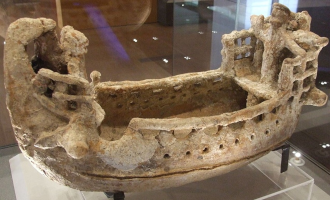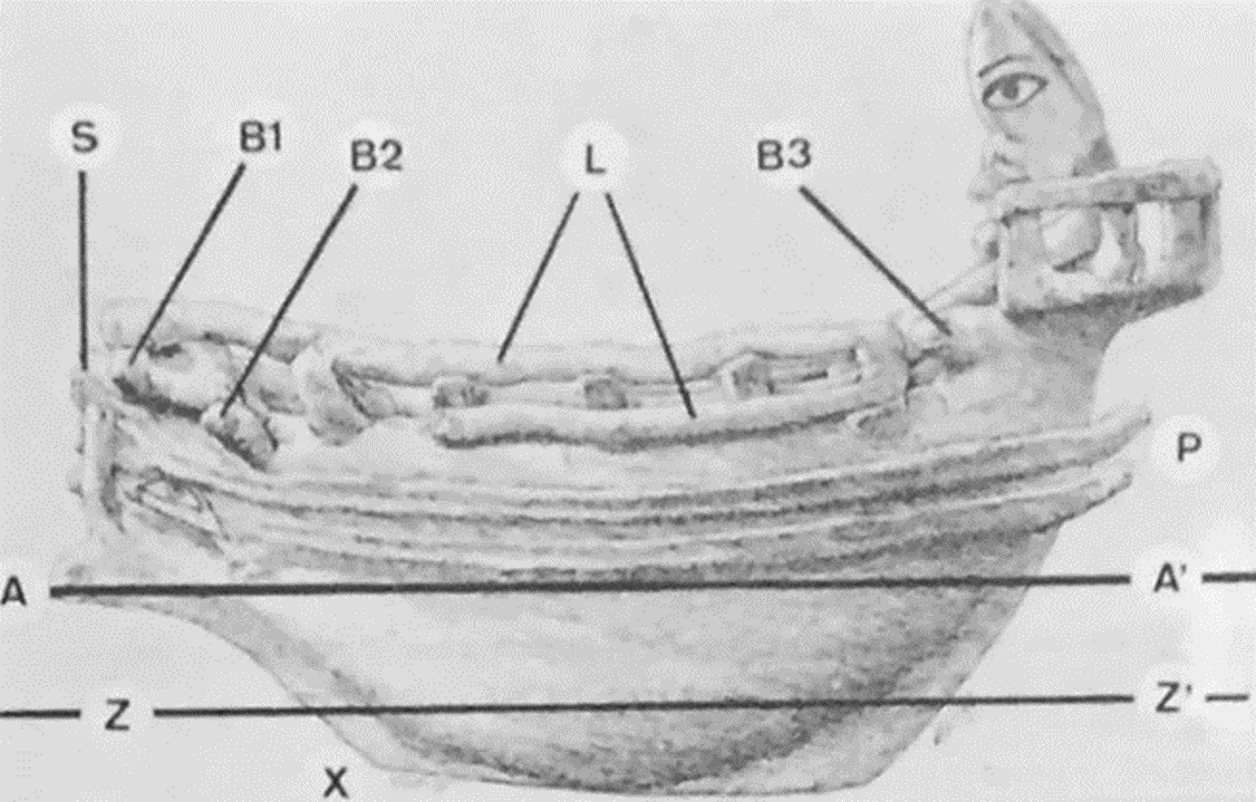Broad crescentic hull with a rounded bottom and a pronounced keel. The keel does not appear to be formed by a single seamless line but rather consists of two parts: one concave section running from the bow projection (A) to line X, and another that curves upwards normally up to point A'. Following the sheer on either side of the hull below the gunwale is a pair of parallel molded wales that join at the stems. These could have functioned either to strengthen the construction or to protect the hull against damage while docking at a quay. There is a bulwark (L) formed by two horizontal parallel planks fastened upon vertical frames that project separately above the hull. The lower plank is on the outside of the frames, while the upper one is on the inside. The stempost has a slightly downward pointing bow projection above which it rises vertically, with catheads at the bow for the anchor. The stern has a semicicular gallery protected by a rail supported by short vertical stanchions. There is a cross-beam between the bulwark and the stern pulpit, placed on top of the gunwale and projecting on either side of the hull (B3). Below the cross-beam inside the hull there is a small thwart. There is another short cross-beam or thwart aft of the stempost (B1). Immediately aft of this bow thwart inside the hull there is a mast-socket. Sitting on the stern pulpit with his back against the rail is a male figure, his arms extended over the cross-beam and resting on the gunwale. The legs are indicated by dark painted stripes across the thwart. A big oval eye and eyebrow are also painted. The figure likely represents the helmsman. Basch argues that line A should be interpreted as the ship's water line.
Ship model
C25
Cypro-Archaic
Amathus
L: 25.7 cm; H (amidships): 10.7 cm
Terracotta boat model with some traces of colour
Barnes and Salzman 1998: 82; Basch 1987: 250, 252-54, no. 536-42; Casson 1971: 66-67, fig. ; Cesnola 1877: 259; 1894: no. 702, pl. LXXVII; Dolan 2023: 428-431, no. 44; Göttlicher 1977: 36, no. 162, pl. 11; Hermary 2000: 49; Karageorghis 1995a: 130, no. II(vi)10, pl. LXXVI.4; Karageorghis et al 2000: 158, no. 253; Karageorghis et al 2016: 56, 255, no. 91; McClees and Alexander 1933: 117, 120, fig. 146; 1941: 117, 120, fig. 146; Mertens 2010: 48-49, fig. 25; Myres 1914: 348, no. 2127; Picón 2007: 246, 462, no. 287; Westerberg 1983: 41-42, no. 50, fig. 50
Barnes, L. and E. Salzman. 1998. "Preliminary Investigations of Surface Decoration on a Group of Ancient Terracottas from Cyprus." In: A.B. Paterakis (ed.) Glass, Ceramics and Related Materials : ICOM Committee for Conservation Glass, Ceramics, and Related Materials Working Group, & Institute of Arts and Design Department of Conservation Studies. Vantaa, Finland: EVTEK Institute of Art and Design, Dept. of Conservation Studies.
Basch, L. 1987. Le musée imaginaire de la marine antique. Athens: Institut Hellénique pour la preservation de la tradition nautique.
Casson, L. 1971. Ships and Seamanship in the Ancient World. Princeton: Princeton University Press.
Cesnola, L.P. di. 1877. Cyprus: its ancient Cities, Tombs, and Temples: a Narrative of Researches and Excavations during ten Years’ Residence as American Consul in that Island. London: John Murray.
―――. 1894. A Descriptive Atlas of the Cesnola Collection of Cypriote Antiquities in the Metropolitan Museum of Art, New York. Vol. 2. Boston: James R. Osgood and Company.
Dolan, M. 2023. Ceci n'est pas un bateau: Reassessing terracotta boat models in Late Bronze and Iron Age Cyprus. University of Southhampton. Unpublished DPhil Thesis.
Göttlicher, A. 1978. Materialien für ein Korpus der Schiffsmodelle im Altertum. Mainz: Philipp von Zabern.
Hermary, A. 2000. Amathonte: Les figurines en terre cuite, archaïques et classiques, les sculptures en pierre, Vol. 5. Paris: Éditions Recherché sur les Civilisations.
Karageorghis, V. 1995a. The Coroplastic Art of Ancient Cyprus. IV. Nicosia: A.G. Leventis Foundation.
Karageorghis, V., G. Merker and J. R. Mertens. 2016. The Cesnola Collection of Cypriot Art: Terracottas. New York: The Metropolitan Museum of Art.
Karageorghis, V., J. Mertens and E.R. Marice 2000. Ancient Art from Cyprus: The Cesnola Collection in The Metropolitan Museum of Art. New York: The Metropolitan Museum of Art.
McClees, H. and C. Alexander. 1933. The Daily Life of the Greeks and Romans: As Illustrated in the Classical Collections. 5th ed. New York: The Metropolitan Museum of Art.
―――. 1941. The Daily Life of the Greeks and Romans: As Illustrated in the Classical Collections. 6th ed. New York: The Metropolitan Museum of Art.
Mertens, J. R. 2010. How to Read Greek Vases. New York: The Metropolitan Museum of Art.
Myres, J. L. 1914. Handbook of the Cesnola Collection of Antiquities from Cyprus. New York: The Metropolitan Museum of Art.
Picón, C.A. 2007. Art of the Classical World in the Metropolitan Museum of Art: Greece, Cyprus, Etruria, Rome. New York: The Metropolitan Museum of Art.
Westerberg, K. 1983. Cypriote Ships from the Bronze Age to c. 500 B.C. (SIMA, Pocket-books, 22). Göteborg: P. Åströms förlag.









